Linguine al Limone is a creamy pasta that bursts with the bright flavors of summer. Lemon juice, lemon zest, and a touch of basil add freshness, while the Parmigiano Reggiano cheese, butter, and pasta water create a starchy sauce that when tossed with the pasta, creates a luxurious and decadent dish that definitely lands it in the comfort food category. And with 5 main ingredients you probably have on hand, this can be made quickly, and simply, without running to the store.
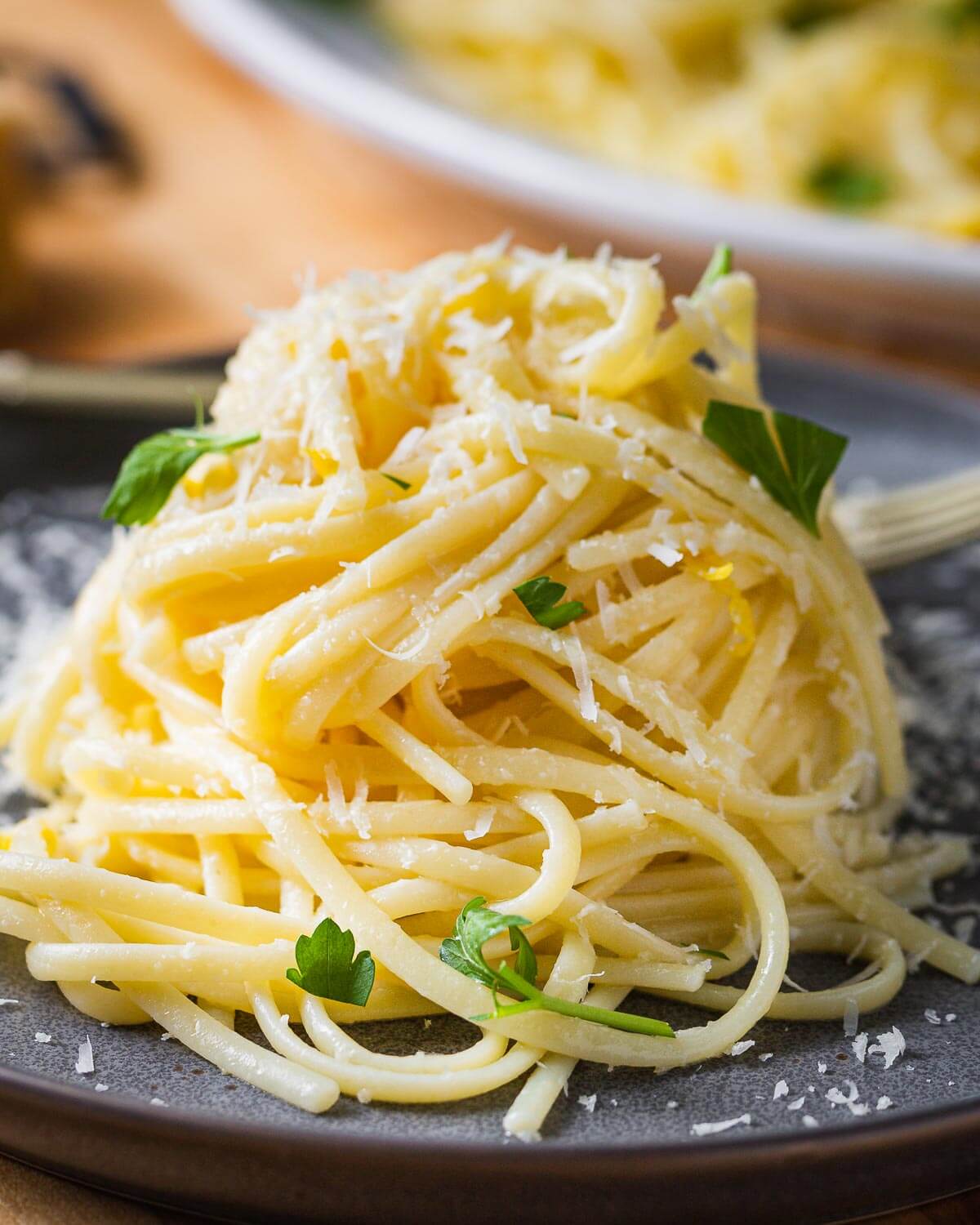
Pasta al limone is the dish I make when I’m in the mood for fettuccine alfredo, but want something that tastes a little bit lighter, and brighter.
Al limone is very similar to Alfredo in that Alfredo includes the same core ingredients: butter, pasta water, and Parmigiano Reggiano. It is definitely a filling dish.
But the lemon juice and lemon zest somehow make linguine al limone taste a little less heavy.
Technique
The technique used to make the sauce for pasta al limone is the same as the technique for making bucatini cacio e pepe, spaghetti alla Nerano, and fettuccine Alfredo.
The technique involves tossing the pasta in the pan with the cheese, pasta water, and in the case of al limone, butter.
This process allows the ingredients to emulsify, and create a creamy texture that clings to the linguine.
To see my technique on how to make this exact recipe, watch my YouTube video below in the recipe card.
Essentially, all pasta should be tossed, or flipped, using this method, but for al limone, cacio e pepe, and the others listed above, it is critical to the success of the dish.
The technique isn’t hard to learn – it just takes a little patience. But once you’ve learned it you will use it all the time and you can impress your friends or family with your fancy flipping skills. 😉
Note: you may find other recipes that use heavy cream to make al limone. Traditionally, this recipe does not call for heavy cream, although it may help you achieve that creamy texture if you’re not comfortable with tossing/flipping. Think of it as a cheat code. And don’t feel guilty about it – I too sometimes use heavy cream, such as in my creamy garlic mushroom pasta and fettuccine alfredo recipe.
Want To Save This Recipe?
How to make linguine al limone
Each number corresponds to the numbered written steps below.
- Zest 2 medium-sized lemons and roughly chop the zest. Once zested, juice the same lemons until you have ~5 tablespoons of lemon juice. The amount of juice you get from lemons will vary. Pro tip: To maximize the amount of juice you get from a lemon, run it under warm water, then roll it on top of a clean surface while applying downward pressure before slicing it in half.
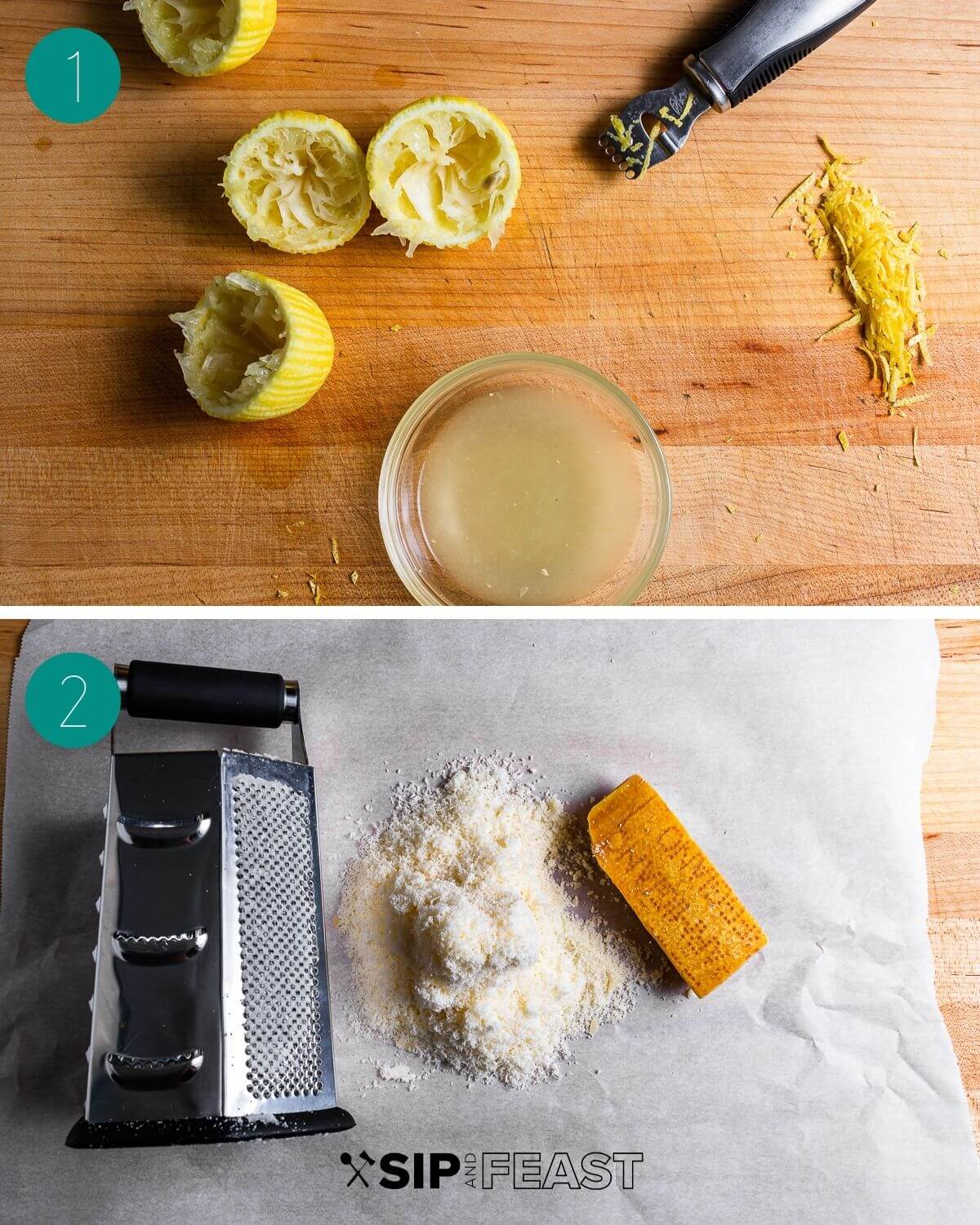
- Using the fine edge of a cheese grater, grate 1 1/4 cups of Parmigiano Reggiano cheese. Bring a pot of water to a boil adding 2 tbsp of kosher salt per gallon of water and begin to cook the linguine until al dente.
- A few minutes before the pasta is done cooking, heat a pan to low heat and add the butter and olive oil. Then, add half the lemon zest and allow it to cook for 1-2 minutes.
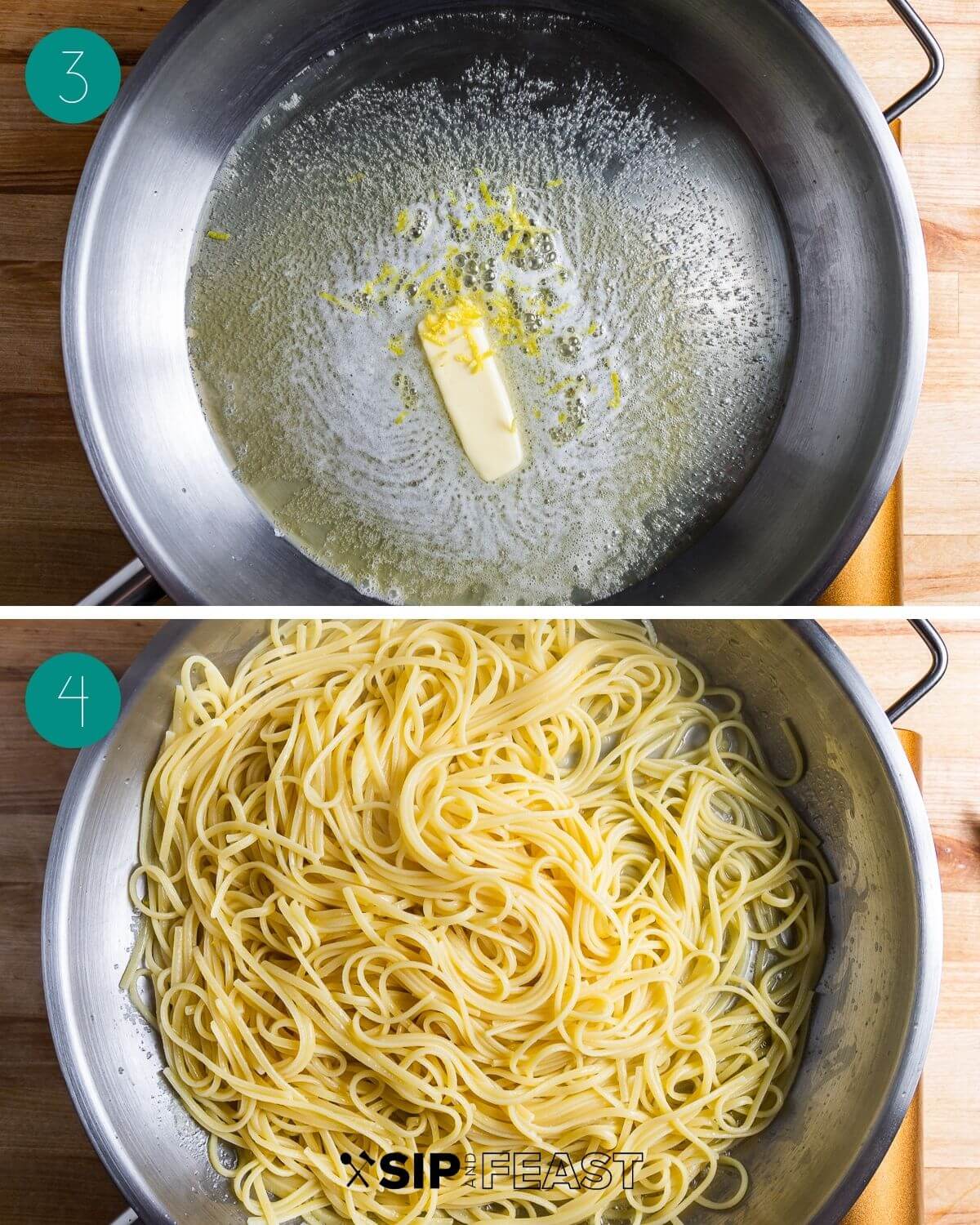
- Pull your linguine out of the pot using tongs and place the al dente pasta in the pan with the butter, olive oil, and zest. Toss, or stir to incorporate.
- Add the lemon juice and toss again to coat. Turn the heat off the pan and wait 30 seconds. Then, begin adding the cheese a little bit at a time.
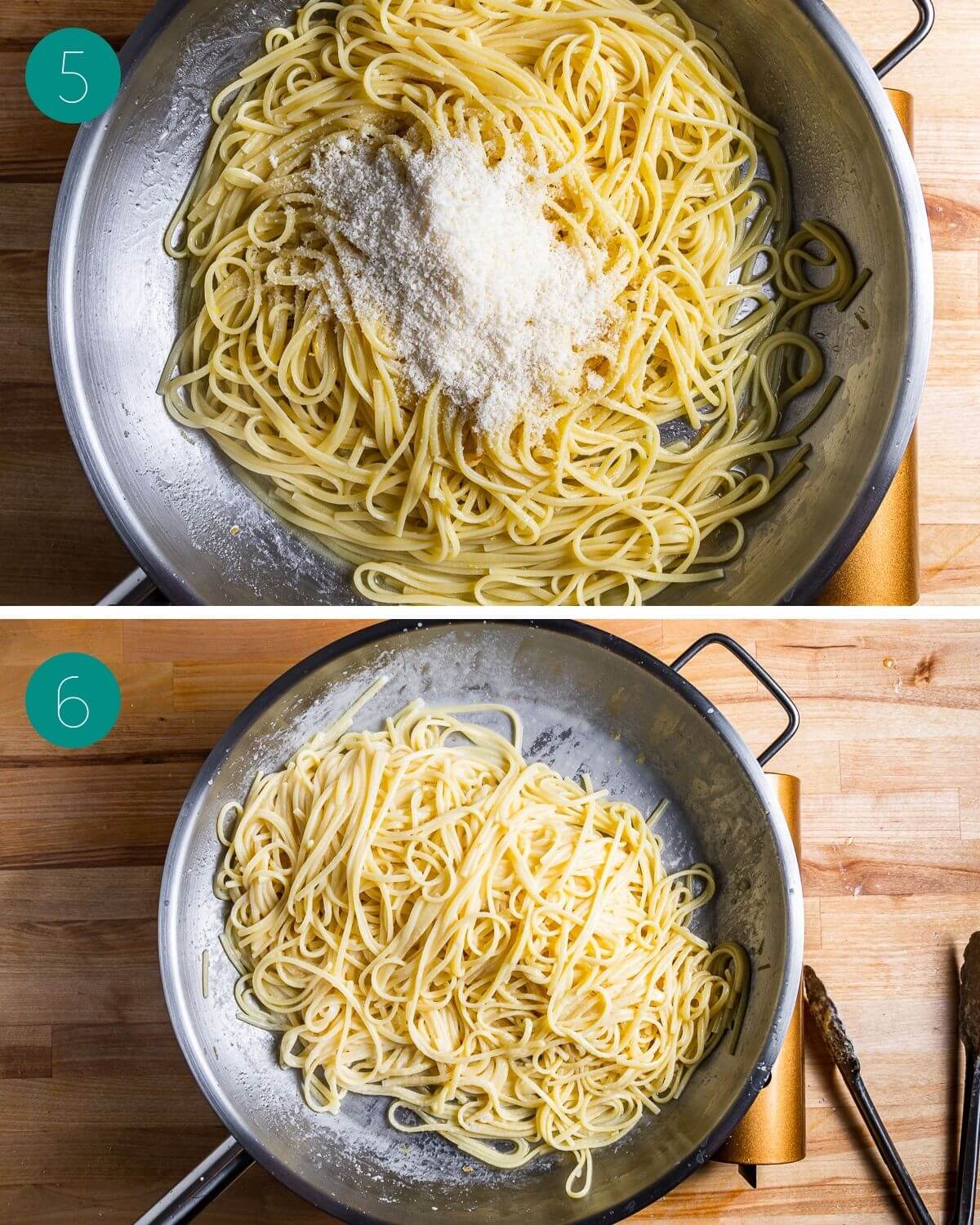
- Toss and stir quickly to emulsify. If the sauce is too thick, add some pasta water, a tablespoon or two at a time, until the consistency is just right. Taste test and add kosher salt and pepper to taste. Serve immediately as the pasta can dry out quickly. If needed, add a bit more cooler pasta water and toss again right before serving to loosen the pasta back up. Top each plate with a touch of the remaining zest, and a sprinkle of basil or parsley (completely optional), and more grated Parmigiano Reggiano. Enjoy!
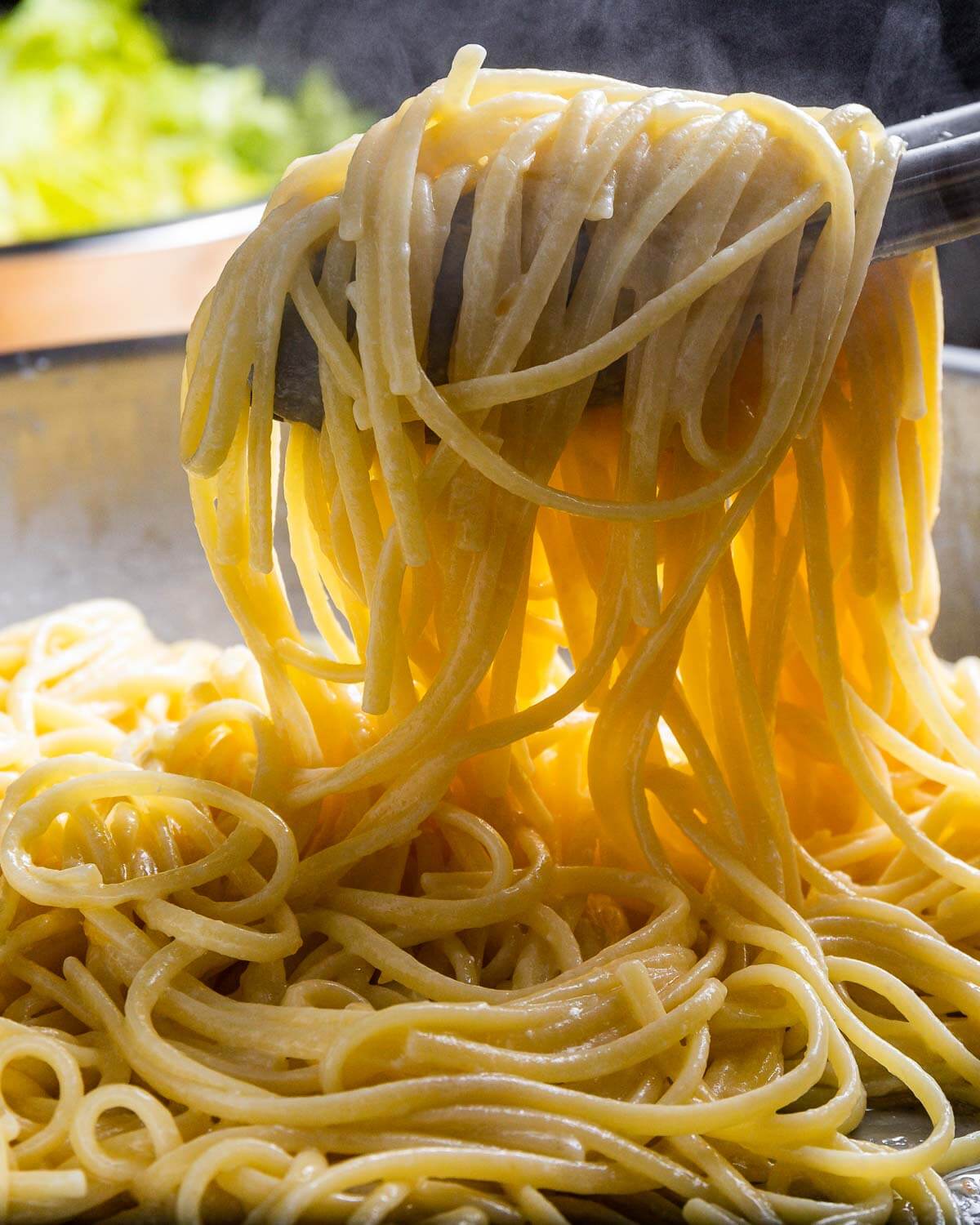
More lemony goodness
It is no surprise that I love lemon. My grandmother’s family was from Southern Italy where lemons are a religion, so you could say the love of lemon is in my blood.
And if you are looking at linguine al limone, it’s a safe bet that you too love lemons. If that is true, check out these other foods that include lemon in some way, shape, or form.
- Lemon caper pasta
- Creamy lemon chicken pasta
- Lemon ricotta stuffed zucchini
- Lemon garlic shrimp pasta
- Limoncello spritz – the perfect cocktail for summer gatherings
- Chicken francese
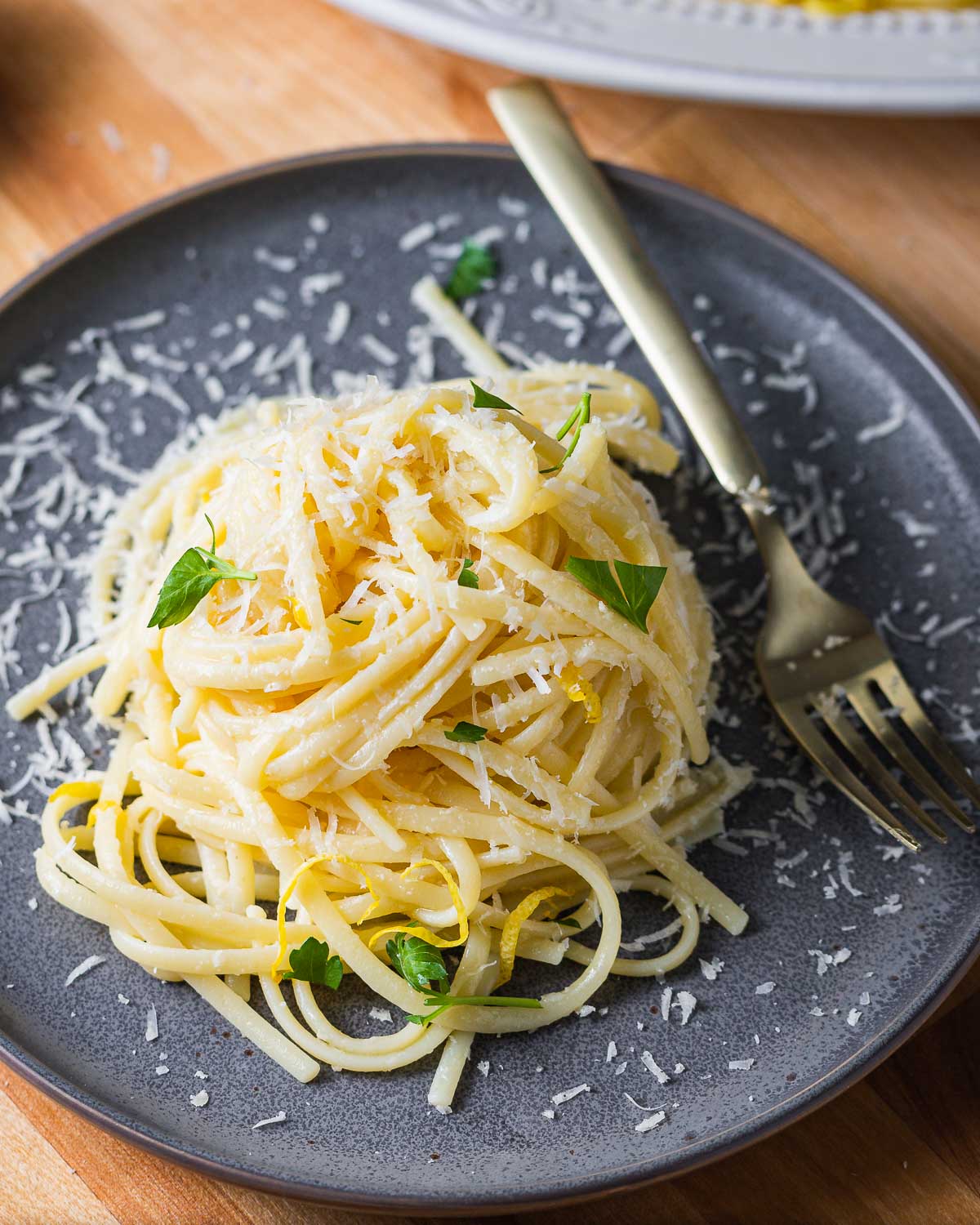
What to serve with linguine al limone
The cheese and butter make this a heavier dish. For that reason, I like to serve pasta al limone with a lighter side.
Salads, such as chickpea and arugula salad, or Via Carota’s green salad, would be perfect.
Sauteed greens would also be a great side, such as broccoli rabe with garlic, or sauteed spinach.
If you’ve enjoyed this Linguine al Limone recipe, or any recipe on this site, we want to know so tell us in the comments below. We would love to hear how you did and it’s nice to show others as well. Thanks!
Watch the video below where Jim will show you how to make this recipe with easy to follow instructions. Some people learn by watching. If you’re that type of person, you can find most of our recipes on YouTube and our Facebook Page.
Linguine al Limone
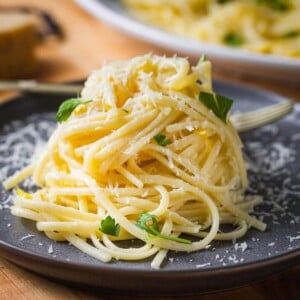
Ingredients
- 1 pound linguine or spaghetti, fettuccine, etc
- 4 tablespoons unsalted butter
- 2 tablespoons olive oil
- 1 1/4 cups Parmigiano Reggiano cheese finely grated, plus more for serving
- 5 tablespoons lemon juice
- 2 medium lemons, zested divided
- salt and pepper to taste
- 2 tablespoons basil chopped
- 2 cups reserved pasta water will not need all of it
Want To Save This Recipe?
Instructions
- Cook pasta to al dente in salted water (2 tbsp kosher salt per gallon of water).
- A few minutes before the pasta finishes cooking heat a pan to low and add the butter and olive oil. Add half the lemon zest and let it cook for a minute or two.
- Add the wet (pull pasta out with tongs) al dente pasta to the pan and stir and/or toss to incorporate.
- Add the lemon juice and toss to coat. Turn the heat off. Wait 30 seconds, then begin adding the cheese a bit at a time. Toss and stir quickly to emulsify. If the sauce is too thick add a bit more pasta water (a tablespoon or two at a time) to get the consistency just right.
- Test and add kosher salt and pepper to taste. Serve immediately as the pasta can dry out quickly. If needed add a bit more cooler pasta water and toss right before serving to loosen the pasta right back up. Top each plate with a touch of the remaining zest and a sprinkle of basil or parsley. Serve with more grated parmesan. Enjoy!
Notes
- Tossing pasta in the pan will help emulsify the sauce of pasta water, cheese, and lemon juice. It's a good skill to learn and will massively improve your pasta recipes!
- If the cheese clumps don't worry. It can be loosened up with cooler pasta water or even cold tap water.
- Leftovers can be saved for up to 3 days in the fridge, but pasta al limone is best served and eaten right away.
Nutrition
Nutrition information is automatically calculated, so should only be used as an approximation.
Follow Me
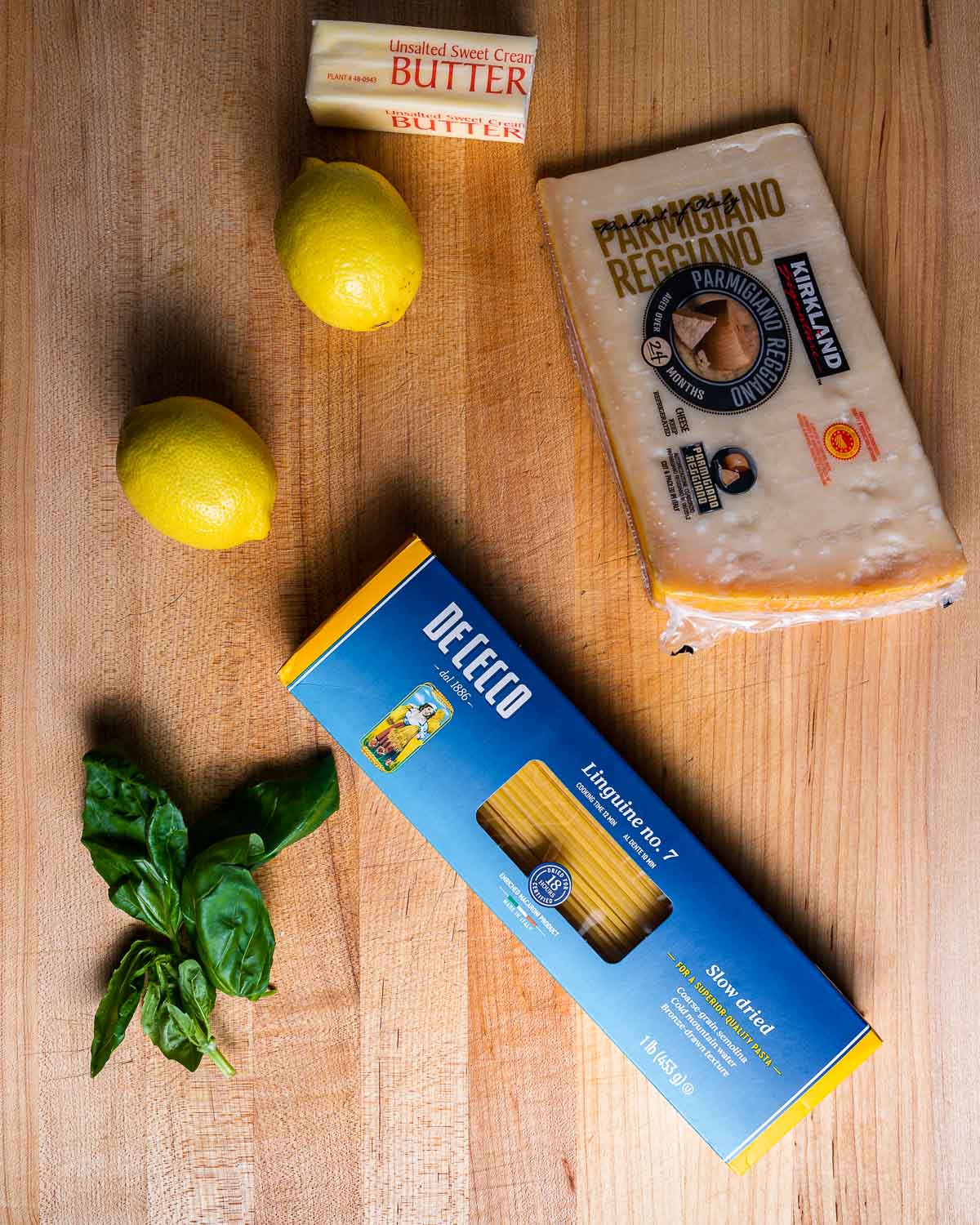







I am wondering how or if I can prep this ahead of guests coming for dinner, perhaps 30 min – 1 hour ahead?
Hi Judy, you can make it ahead but be sure to save your pasta water as you’ll likely need to add some to reheat and reconstitute the pasta right before serving.
Linguine al Limone
I was wondering if you have ever made this dish using limoncello in the recipe? Seems to me it would add a lot of depth. I use limoncello when doing my shrimp dish and I am thinking of combining the two together.
I was wondering about recplacing the parm with pecorino.
Hi Debbie, we haven’t tried this with limoncello but if you do give it a try, let us know how it turns out! You can use Pecorino but keep in mind it’s saltier than Parmigiano Reggiano so you may not need as much salt.
This recipe has become one of my favourites! It “checks all the boxes” for me, especially since I am definitely a fan of all things lemon. Very tasty, light, perfect all year around, and versatile. Occasionally, I add one other ingredient, such as some chopped sundried tomatoes, which would seem to be compatible. SIDE NOTE: I love the Podcasts. Interestingly, I watch the videos of them after the day’s work is completed because in addition to being interesting and educational, they are also wonderfully calming, due in no small part to Tara’s voice and also the dynamic between the two of you. I am so glad that I discovered your videos on YouTube and your Website all those months ago, and am subscribing to your E-mailed recipes, seasonal suggestions, etc. I also appreciate that you sometimes “tweak” the recipes here on your Website because, unlike the videos, you can make periodic updates or changes over time — which is good to know. Thanks for all the hard work the two of you do.
Hi Ellen, thanks for the kind words and we’re so happy you enjoy this recipe but the podcasts, videos, and emails as well. We appreciate you taking the time to let us know!
Hey Jim,
I love your show and you’re style of cooking. Is it somehow possible for you to also offer your recipes in metric measurements? Thanks a lot!
Hi Rene, thanks for the comment. I usually include metric information for the dessert and baking recipes, and almost always include the metric information on the YouTube description of the recipe. We’re in the process of trying to figure out how best to offer this information on the website for all recipes – it’s a work in progress. Many of the automated ways to do it provide inaccurate conversions from imperial to metric which will provide a worse experience to the user. It is on our radar though. Thanks for following along, we appreciate it!
Question: In your video you said to use a half pound of pasta, but the recipe says one pound. In the recipe you double the cheese (compared to the video) but not the butter and olive oil.
I’m a little confused.
Any help you can offer is appreciated. Your website is brilliant. I love it.
Hi Joey, thanks for the comment. A good rule of thumb is to always follow the written instructions as opposed to the video. Often times I’ll tweak the written recipe to make improvements but I can’t change the video. With regards to doubling the cheese, when you scale a recipe up or down, not everything needs to be doubled or halved. For example, in this recipe I only increased the butter by 1 tablespoon and didn’t increase the olive oil because that was enough to create a good emulsion. I hope that makes sense, and so happy you’re enjoying the website. Let me know if you have any more questions on this.
I continue to be amazed at how these recipes turn out so delicious with just a few ingredients. I’ve also learned some techniques from watching your videos, so thank you for that!
Hi Dave, I’m so happy you enjoyed this recipe and the videos and really appreciate the comment.
Awesome!
Hi Ed, I’m so happy you enjoyed and appreciate the comment!
I used to get the Chicken Limone at The Newbridge Cafe in Chelsea, MA. Reading this brought me back 30 years and a few hundred miles! Going to serve this with chicken cutlets! Thanks Jim!
Hi Max, thanks for the comment and hope you enjoy!
We just made this for the second time — delicious! Definitely worth having extra lemon juice on hand. And the pasta water makes a big difference! thanks for a great recipe, Jim!
Hi Joe, I’m so happy to hear you liked this recipe enough to make it a second time! I appreciate the comment, thank you!
Omg Wifey loved this in our regular rotation ❤️🍷
Hi Alan, so happy you and your wife enjoyed this one! Thank you for the comment!
So delicious, thank you
Thank you, Annette! So happy you liked it!
Fantastic! Love the freshness and ease to prepare, now one of my all time favorites! Thank you.
Thank you, Paula! So happy you liked this one!
Is it possible to use some lemon cello?
Hi Denise, I have not tested this recipe with limoncello so can’t say for sure how it would turn out. I’d probably just stick with the lemon juice as limoncello tends to be very sweet and may change the integrity of the dish.
New to me but doable. Love lemons.
Hope you enjoy it, Bev!
This sounds amazing!!! Basil. Lemon…! Perfection!!! Making this for sure!!
Thanks! Hope you enjoy it!